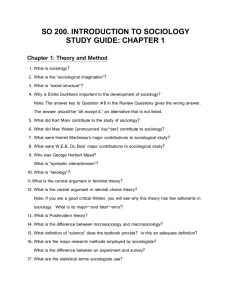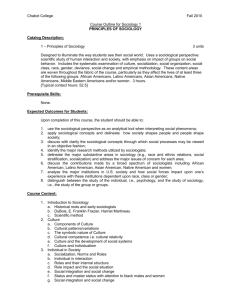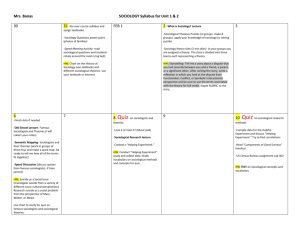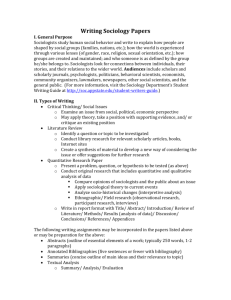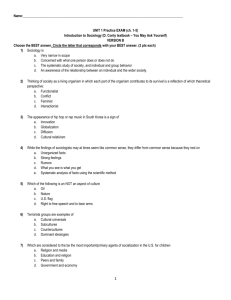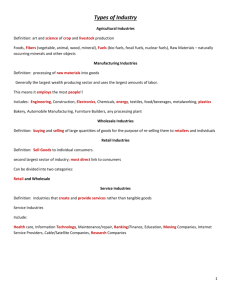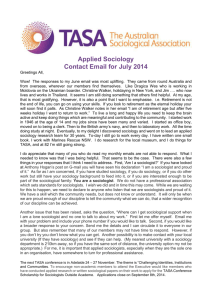Sociology Final Test Bank revision1–2014-2015
advertisement
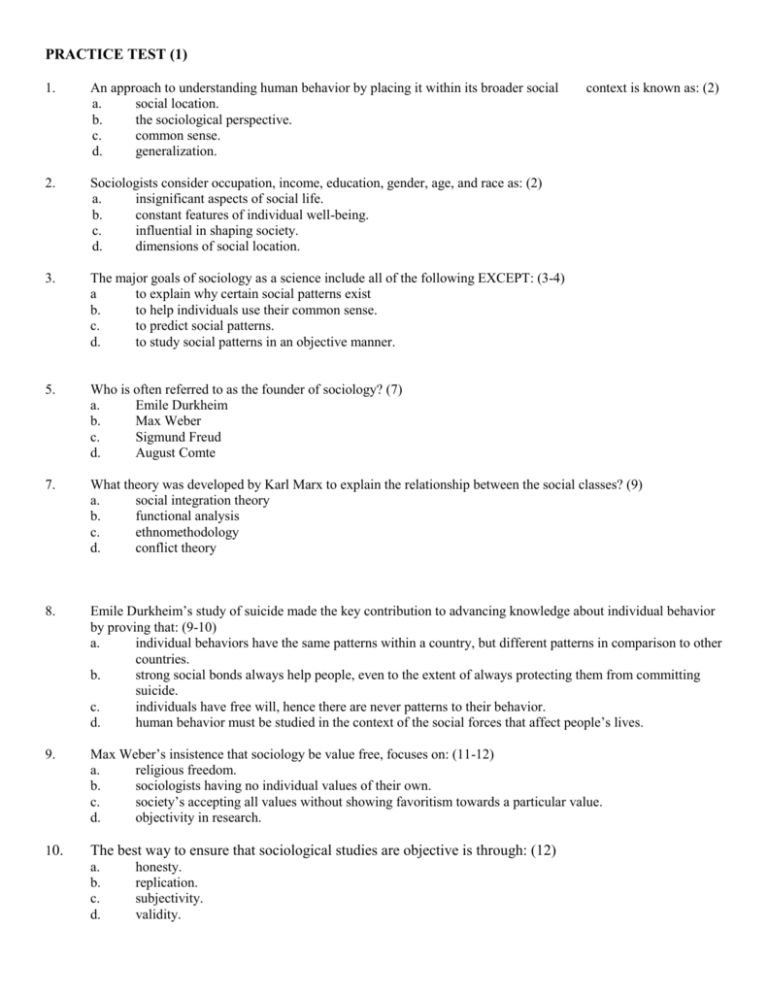
PRACTICE TEST (1) 1. An approach to understanding human behavior by placing it within its broader social a. social location. b. the sociological perspective. c. common sense. d. generalization. 2. Sociologists consider occupation, income, education, gender, age, and race as: (2) a. insignificant aspects of social life. b. constant features of individual well-being. c. influential in shaping society. d. dimensions of social location. 3. The major goals of sociology as a science include all of the following EXCEPT: (3-4) a to explain why certain social patterns exist b. to help individuals use their common sense. c. to predict social patterns. d. to study social patterns in an objective manner. 5. Who is often referred to as the founder of sociology? (7) a. Emile Durkheim b. Max Weber c. Sigmund Freud d. August Comte 7. What theory was developed by Karl Marx to explain the relationship between the social classes? (9) a. social integration theory b. functional analysis c. ethnomethodology d. conflict theory 8. Emile Durkheim’s study of suicide made the key contribution to advancing knowledge about individual behavior by proving that: (9-10) a. individual behaviors have the same patterns within a country, but different patterns in comparison to other countries. b. strong social bonds always help people, even to the extent of always protecting them from committing suicide. c. individuals have free will, hence there are never patterns to their behavior. d. human behavior must be studied in the context of the social forces that affect people’s lives. 9. Max Weber’s insistence that sociology be value free, focuses on: (11-12) a. religious freedom. b. sociologists having no individual values of their own. c. society’s accepting all values without showing favoritism towards a particular value. d. objectivity in research. 10. The best way to ensure that sociological studies are objective is through: (12) a. b. c. d. honesty. replication. subjectivity. validity. context is known as: (2) 15. In the 1940s the central focus of sociology: (19) a. shifted from data gathering to social activism. b. shifted from social reform to social theory. c. shifted from theories developed in America to theories developed in Europe. d. shifted from predicting behavior to explaining behavior. 16. Sociologists who research social problems for government commissions or agencies are: (20) a. politically correct. b. basic sociologists. c. applied sociologists. d. pure sociologists. 20. Conflict theory sees the modern increase in divorce rates as: (27) a. the weakening importance of the role of the family. b. a sign that women are making headway in their historical struggle with men. c. a change in the symbolic meaning associated with marriage and divorce. d. an indication that attorneys now have the greatest influence on the informal legal structure. 22. According to your text, which theoretical perspective is best for studying human behavior? (28) a. the functionalist perspective b. the symbolic interactionist perspective c. the conflict perspective d. a combination of all of the above. 23. The first phase of sociology in the United States was characterized by: (29) a. b. c. d. a concern with establishing sociology as a social science. a focus on establishing sociology as a respectable field of knowledge. an interest in using sociological knowledge to improve social life and change society. a broad acceptance of women and racial minorities within the discipline. 24. What is the American Sociological Association promoting? (30) a. that sociological data is used more often by politicians and policy makers. b. that sociologists do research that is value free. c. that sociological research is emphasized. d. none of the above. 25. What trend does the author of your text suggest is likely to transform the scope and focus of U.S. sociology in the future? (31) a. race, class, and gender inequalities b. cultural diversity c. technology d. globalization PRACTICE TEST (2) 1. Beliefs, language, and values are examples of: (36) a. nonmaterial culture. b. material culture. c. folkways. d. technology. 2. An emphasis on the “culture within us” can often lead to: (37) a. ethnocentrism. b. cultural relativism. c. objectively understanding other cultures. d. only the negative consequences of ethnocentrism. 3. Which of these statements regarding culture is not true? (38) a. people generally are aware of the effects of their own culture. b. culture touches almost every aspect of who and what a person is. c. at birth, people do not possess culture. d. culture is the lens through which we perceive and evaluate what is going on around us. 4. When we try to understand a culture on its own terms without judging elements of culture as superior or inferior to our own way of life, we are practicing: (38) a. stereotyping. b. cultural relativism. c. mores. d. bias. 9. Every group develops expectations about the right ways to reflect its values. These expectations are: (46) a. ideal culture b. real culture. c. norms. d. moral standards. 10. An expression of approval given for following a norm is called a: (46) a. b. c. d. folkway. value. positive sanction. cultural universal. 11. Moral holidays are: (46) a. times when people can break the norms and not be sanctioned. b. often center around people getting drunk and being rowdy. c. celebrations like Mardi Gras. d. all of the above. 12. Serving turkey for Thanksgiving dinner is an example of a: (47) a. vice. b. taboo. c. core value. d. folkway. 13. 14. The author of your text cites having sex with one’s parents as an example of: (48) a. folkways. b. mores. c. taboos. d. a behavior that is universally sanctioned. 15. Subcultures: (48-49) a. are a world within a world. b. have values and related behaviors that set their members apart from the dominant culture. c. include occupational groups. d. are all of the above. 16. What is a counterculture? (49) a. a group which has its own values and norms but identifies with the main culture b. a group which has values in opposition to the dominant culture c. any sub-unit of the main culture d. a group with the same values as the dominant culture 17. U.S. society is made up of many different groups. Which of the following terms would a sociologist use to describe this type of society? (49) a. a melting pot b. a pluralistic society c. a conflicted society d. a counterculture 18. Which of the following statements concerning core values is incorrect? (52-53) a. they are shared by the many groups that make up U.S. society. b. they include achievement and success, individualism, and progress. c. they change over time. d. they rarely create much conflict as they change. 19. According to the author of your text, a new value cluster is emerging in the United States. Which of the following combination of core values make up this new value cluster? (54) a. achievement and success, activity and work, material comfort b. individualism, freedom, democracy, equality c. leisure, self-fulfillment, physical fitness, youngness d. youngness, self-fulfillment, romantic love, material comfort 21. Cultural universals: (56) a. are present in all cultures but specific customs differ from one group to another b. are found in all societies both in general and specific terms. c. are found in specific terms for marriage, funerals, and incest. d. stem from a biological imperative to forbid incest. 23. Which term refers to the custom of maintaining a nine-month school year in the U.S. even though this custom no longer matches the current technology? (58) a. cultural diffusion b. cultural leveling c. cultural hindrance d. cultural lag 24. What would the printing press or the computer be considered? (58) a. inventive technologies b. diffused technologies c. examples of cultural leveling d. new technologies Mexican piñatas often depict Mickey Mouse or Fred Flintstone. This is an example of: (59) a. symbolic culture. b. cultural lag. c. cultural leveling. 25. d. cultural relativism. PRACTICE TEST (3) 1. 3. 4. 5. Charles Horton Cooley’s term looking-glass self emphasizes that: (68) a. our sense of self develops from interaction with others. b. our concept of self depends on our good looks. c. when we look good we feel good. d. humans are instinctively vain. Jean Piaget focused on studying how children develop: (70) a. the ability to understand language. b. the ability to read. c. the ability to perform mathematical equations. d. the ability to reason. 6. What term does Sigmund Freud use to represent the “culture within us,” the norms and values we have internalized for our social groups? (72) a. id b. superego c. eros d. ego 7. Which (73) a. b. c. d. 9. of the four stages of moral development are most people unlikely to ever reach, according to Kohlberg? amoral preconventional conventional postconventional What do we call the ways in which society sets children onto different courses for life purely because they are male or female? (75) a. b. c. d. sex socialization gender socialization masculinization and feminization brainwashing 11. Examples of groups that are early, significant agents of socialization are: (78) a. family groups. b. the group effects produced by schools. c. the group effects produced by mass media. d. the group effects produced by our religion. 12. What do middle-class parents try to develop in their children, according to Melvin Kohn? (80) a. outward conformity b. neatness and cleanliness c. curiosity, self-expression, and self-control d. obedience to rules 13. 14. A latent consequence of the American formal education system is: (83) a. the emergence of a “hidden curriculum.” b. the transmission of knowledge and skills for one to advance in our society. c. the transmission of reading, writing, and arithmetic skills. d. an emphasis on the development of individuality rather than universality. 15. What conclusions can be drawn about peer groups and academic achievement from Adler and Adler's research? (83-84) a. both boys and girls avoid doing well academically. b. boys want to do well academically in order to boost their standing in the peer group, but girls avoid being labeled as smart, because it will hurt their image. c. both boys and girls believe that good grades will translate into greater popularity among their respective peer groups. d. for boys, to do well academically is to lose popularity, while for girls, getting good grades increases social standing. 16. According to Michael Messner, sports encourage boys to develop: (84) a. a love of physical fitness. b. a competitive spirit. c. instrumental relationships. d. a keen appreciate for teamwork. 17. The process of learning new norms, values, attitudes, and behaviors is: (85) a. degradation. b. resocialization. c. leveling. d. anticipatory socialization. 18. 20. 21. 22. Stages we experience from birth to death are called: (86) a. the life course. b. social locations. c. statuses. d. socialization. Which statement best describes adolescence? (88) a. Human nature makes this a time filled with inner turmoil. b. Contemporary society, not biology, makes this a time of inner turmoil. c. In postindustrial societies children are treated as adults. d. It is a natural age division separating innocence from responsibility. 23. Which stage of the lifecourse is a period of extended youth? (88) a. childhood b. adolescence c. transitional adulthood d. pre-adolescence 24. Which stage of the life poses a special challenge for women? (89) a. early middle years b. later middle years c. early older years d. later older years 25. Sociologists believe that the establishment of a sense of “self” is: (91) a. firmly done in early childhood and undergoes very little modification over time. b. dynamic and changes over time. c. a passive process whereby individuals are not actively involved in the construction of self. d. a process that has little effect on our behavior. PRACTICE TEST (4) 3. To a sociologist the term “status” means: (99) a. a person’s occupational prestige level. b. a person’s position in a society or social group. c. a social group’s prestige level. d. a social group’s position in society. 4. An ascribed status is: (99) a. involuntary. b. best exemplified by the idea of one’s becoming an attorney. c. independent of what is inherited at birth. d. not related to one’s place in the life course. 5. A master status: (100) a. is independent of one’s ascribed status. b. cuts across other statuses one might hold. c. can stem only from one’s achieved status. d. is subordinate to one’s individual ascribed and achieved statuses. 6. A contradiction or mismatch between an individual’s statuses: (100) a. is known as status inconsistency. a. leads to a smooth unfolding of the relationship between status and social interaction. c. is in conformity with the modern expectations of everyday society for most statuses. d. is independent of norms. 7. Which of the following describes an individual’s race, gender, and inherited social class? (99-100) a. ascribed status b. achieved status c. status inconsistencies d. status incongruities 8. The behaviors, obligations, and privileges attached to a status are called: (100) a. status symbols. b. master status indicators. c. roles. d. limitations. 9. Wedding rings, military uniforms, and clerical collars are all examples of: (100) a. social stigma. b. social class. c. status symbols d. achieved statuses. 10. A ___________ consists of people who regularly interact with one another. (101) a. group b. role c. status d. status set 11. The organized ways a society meets its basic needs are called: (101) a. social institutions. b. roles. c. d. 12. 13. groups. status assignments. According to _____________, social institutions are used by the elite for its own advantage? (104) a. functionalists b. conflict theorists c. symbolic interactionists d. dramaturgists PRACTICE TEST (9) 1. What term applies to the division of large numbers or groups of people into layers according to their relative power, property, and prestige? (231) a. diversification b. networking c. stratification d. structure 2. Social stratification refers to: (231) a. an individual’s place in a social class hierarchy. b. a concept based on wealth, such as property, but not based on power. c. power only as it applies to wealth such as property. d. relative privileges. 7. Vertical social mobility is possible in a system based on: (236) a. matters independent of money or material possessions. b. caste. c. estate. d. class. Karl Marx called the group that controlled the means of production the: (237) a. bourgeoisie. b. proletariat. c. estate class. d. upper class. 8. 9. 10. 11. According to Karl Marx, which of the following is the term for workers’ mistaken identification of themselves with the capitalists? (237) a. class error b. false advancement c. false consciousness d. upward mobility A form of social stratification in which positions are awarded based on merit is called a(n): (239) a. meritocratic system. b. egalitarian system. c. socialistic system. d. democratic system. 12. Conflict theory, as applied to social stratification, would maintain that: (240) a. labor represents a united concept both in theory and in practice regarding unions. b. African Americans are no longer pitted against whites regarding wages. c. capitalists are triumphing on a global level. d. conflict between men and women is no longer over power but is now strictly over a matter of wealth. 13. In order to maintain their relative position in society, the ruling elites in democracies: (241-242) a. use technology to help further democracies. b. manipulate the media to selectively release information. c. pay no attention to checks and balances that exist in society. d. rely less and less on technology to scrutinize security. 14. The classification Most Industrialized Nations includes: (244) a. b. c. d. Canada, Brazil, and the United States. the United States, Switzerland, and South Africa. France, Germany, and Australia. Japan, Kuwait, and the United States. 16. One significant characteristic of the Least Industrialized Nations is the fact that: (248) a. they occupy three-fourths of the land’s surface. b. they represent over two-thirds of the world’s population. c. most residents now have access to trained physicians. d. these countries have a low percentage of the overall growth rate of the world population. 17. Why is it difficult to know how to classify some nations into a global system of stratification? (248) a. it is difficult because the lines that separate the three levels — Most Industrialized, Industrializing, and Least Industrialized — are soft. b. some nations have moved beyond industrialization, becoming “postindustrial” nations. c. some nations have not yet industrialized but are still extremely wealthy. d. all of the above reflect problems with classifying nations into a global system. 22. Why do most sociologists reject the culture of poverty theory in trying to explain global stratification? (254) a. because it was developed by an economist, not a sociologist b. because it is outdated c. because focuses on culture rather than social structure d. because it places the blame for poverty on the poor nations themselves, rather than focusing on the international arrangements that benefit some at the expense of others 23. Neocolonialism refers to: (254) a. recent efforts by the Most Industrialized Nations to colonize Least Industrialized Nations. b. the economic policies of the Most Industrialized Nations that are designed to control the markets of the Least Industrialized Nations. c. programs like the Peace Corps that attempt to teach residents of the Least Industrialized Nations the skills necessary to survive in an industrial society. d. the economic policy of the Least Industrialized Nations in which they hold the Most Industrialized Nations hostage by controlling access to national resources like oil. 24. According to the neocolonialist argument, why do so many of the Least Industrialized Nations remain poor? (254) a. the Most Industrialized Nations set the prices they will pay for these nations’ raw materials and natural resources. b. the Most Industrialized Nations sell these nations weapons and manufactured goods on credit. c. the capital needed to develop the industrial capacity of these nations is used to pay off their debts to the Most Industrialized Nations. d. all of the above. 25. Which of the following countries have been able to enter the race for global domination because of technology and outsourced labor? (255) a. Korea and India b. China and India c. Russia and Yugoslavia d. Hungary and Hong Kong PRACTICE TEST (10) 1. According to your text, on what do most sociologists agree concerning social class? (260) a. it has a clear-cut, accepted definition in sociology. b. it is best defined by the two classes as set out by Marx. c. it is best defined by Weber's dimensions of social class. d. it has no clear-cut, accepted definition and thus is used differently by all sociologists. 2. The top 10 % of the wealthiest families in America: (261) a. own 36% of all the wealth in America. b. own 40% of all the wealth in America. c. own 25% of all the wealth in America. d. own 68% of all the wealth in America. 3. Which of the following statements best describes changes in the distribution of U.S. income? (262) a. the income distribution has remained virtually unchanged across time. b. the percentage of income going to the richest 20 percent of U.S. families has declined while the percentage going to the poorest 20 percent has increased. c. the percentage of income going to the middle income groups has increased at the expense of groups at both the top and bottom of the income scale. d. the percentage of income going to the richest 20 percent of U.S. families has increased while the percentage going to the poorest 20 percent has decreased. 5. C. Wright Mills’ notion of the power elite in America refers to: (263) a. a concentration of power that contradicts America’s ideology of equality. b. its giving input for domestic policy, but not foreign policy. c. Domhoff’s idea that no one group could become so powerful. d. the idea that its members do not share like-minded values or vested interests. 6. Which of the statements regarding the jobs that have the most prestige is not true? (265) a. they pay more. b. they require more education. c. they require special talent or skills. d. they offer greater autonomy. 10. According to Gilbert and Kahl, the members of which social class can attribute their location in the class system to having a college or postgraduate education? (269) a. the capitalist class b. the upper middle class c. the lower middle class d. the working class 11. Which of the following statements best describes the place of the homeless in our system today? (272) a. they are on the lowest rung with little or no chance of climbing anywhere. b. they are the “fallout” of our developing postindustrial economy. c. in another era, they would have had plenty of work as unskilled laborer. d. all of the above. 12. What factor or factors explain the social class difference in death rates? (274) a. two-tiered system of medical care b. lifestyle differences c. unequal access to medical care d. all of the above. 13. Which of the following statements about social class differences in mental health is correct? (274) a. b. c. d. 14. 16. the rich have less control over their wealth, since it is invested in the stock market, so they worry more about becoming poor. the poor have less job security and lower wages than the nonpoor, which contribute to higher levels of stress. the rich experience more divorce and alcoholism, which can undermine their mental health. the middle class is squeezed by higher and higher taxes, which produces feelings of discontent and poor mental health. According to Melvin Kohn lower-class parents are concerned that their children are: (274) a. creative. b. independent. c. conformists. d. all of the above. In terms of politics, members of the working class are likely to be: (275) a. conservative on economic issues and liberal on social issues. b. liberal on economic issues and conservative on social issues. c. conservative on both economic and social issues. d. liberal on both economic and social issues. 17. Which social class is most likely to be robbed, burglarized or murdered? (275) a. capitalist b. lower c. upper-middle d. elitist 18. Children who grow up in one social class, but end up in a different social class show: (276) a. intergenerational mobility. b. intragenerational mobility. c. horizontal mobility. d. downward social mobility. 19. All of the following are examples of the myths about the American poor EXCEPT: (280) a. that the poor are trapped in a cycle of poverty that few escape. b. most of the poor are white. c. most of the poor are single mothers with children. d. most of the poor live in the inner cities of our country. 20. The pattern of poverty for those in rural areas is such that: (281) a. they are more likely to be single parents than to be married. b. they are more skilled and better educated than most of those in poverty. c. they have a rate of poverty higher than that of the national average. d. the greatest predictor of poverty in America is where one is geographically as opposed to one’s education level or gender. 21. Which of the following groupings of states represent those with the most poverty? (281) a. Iowa, Alaska, South Dakota, Pennsylvania b. Nebraska, Wyoming, Florida, South Carolina c. New Hampshire, Vermont, Georgia, Kentucky d. California, Texas, Mississippi, Alabama As compared to other age groups, the elderly are __________ to be in poverty. (282) a. less likely b. more likely c. equally likely d. most likely 22. 23. Births to single women account for what proportion of all U.S. births? (283) a. b. c. d. one of ten one of five one of three one of every two 24. A conflict theorist would believe that: (285) a. the welfare system exists to reward the poor. b. the welfare system exists to maintain an army of workers in reserve. c. the welfare system helps the poor overcome the oppression of the rich. d. most poor do not deserve to collect welfare. 25. The Horatio Alger myth: (287) a. is beneficial for society, according to the functionalists. b. reduces pressures on the social system. c. motivates people to try harder to succeed because anything is possible. d. all of the above.


